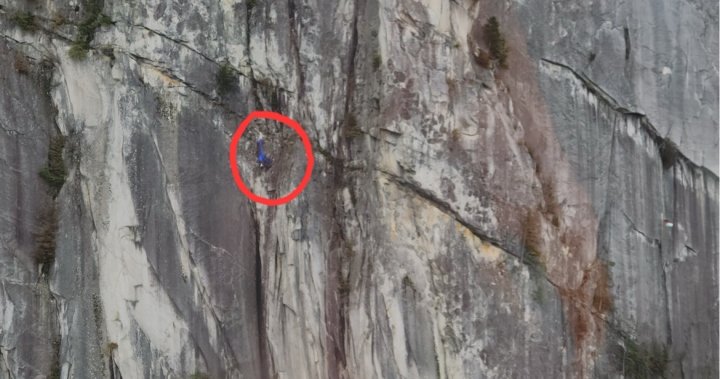Paragraph 1: The Precarious Predicament of a BASE Jumper
On a Wednesday in Squamish, British Columbia, a BASE jumper found herself in a life-threatening situation after her jump from the Stawamus Chief, a popular destination for thrill-seekers. Instead of a smooth descent, she ended up dangling precariously from her parachute, snagged on a small outcropping of rock approximately 100 meters below her takeoff point, with a dizzying 200-meter drop beneath her. The precarious position and the potential dangers posed by the sheer cliff face necessitated the immediate intervention of Squamish Search and Rescue.
Paragraph 2: The Challenges of a High-Stakes Rescue
Responding swiftly to the distress call, the Squamish Search and Rescue team arrived at the scene and initiated a thorough assessment of the situation. After careful consideration, they ruled out a helicopter rescue due to the significant risk posed by the aircraft’s downwash. The powerful gusts of wind generated by the helicopter blades could have easily dislodged the BASE jumper from her tenuous perch, exacerbating the already perilous situation. This meant the team had to resort to a more traditional, yet equally complex, rope rescue operation.
Paragraph 3: Orchestrating the Rope Rescue Operation
The decision to execute a rope rescue brought forth a new set of challenges. It demanded meticulous planning, precise execution, and the coordinated efforts of a large team. A total of 32 Search and Rescue volunteers were mobilized for the operation, underscoring the scale and complexity of the rescue. The team meticulously prepared their equipment, including ropes, harnesses, and safety gear, and strategized the best approach to reach the stranded BASE jumper.
Paragraph 4: Reaching the Stranded Jumper and Securing Her Safety
With the plan in place, the rescue team initiated the descent. A highly skilled team member was carefully lowered down the sheer rock face towards the stranded BASE jumper. Upon reaching her, the rescuer’s priority was to disentangle her from the parachute that had both saved her life and trapped her in this precarious position. Once freed from the parachute’s constraints, the rescuer securely connected the BASE jumper to the team’s robust rope system, ensuring her safety during the final stage of the rescue.
Paragraph 5: The Final Descent and Medical Attention
With the BASE jumper securely attached to the rope system, the rescuer and the jumper were carefully lowered together towards the ground. The remaining team members on the cliff top meticulously managed the ropes, ensuring a slow and controlled descent. Upon reaching the base of the Stawamus Chief, waiting paramedics immediately took charge of the BASE jumper, providing initial medical assessment and transporting her to a waiting ambulance for further evaluation and treatment.
Paragraph 6: Reflecting on a Familiar Rescue Scenario
Mike Teske, the search manager for Squamish Search and Rescue, described the operation as "smooth," attributing the success to the team’s extensive experience in similar rescues in the same area. He noted that this was the third rescue of a BASE jumper in that specific location he had personally been involved in. Teske’s observation highlights the inherent risks associated with extreme sports like BASE jumping and the frequency with which Squamish Search and Rescue is called upon to assist adventurers in distress, including BASE jumpers, rock climbers, and wingsuiters. This recurring need for rescue underscores the importance of safety preparedness, risk assessment, and the invaluable role of search and rescue teams in protecting the lives of those who push the boundaries of human adventure.

